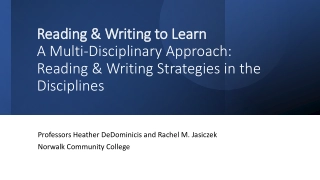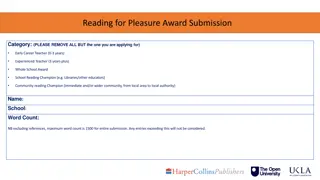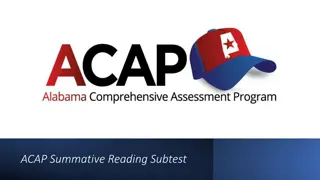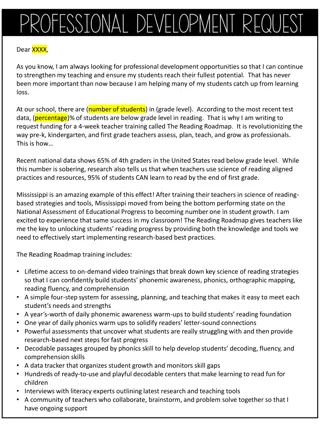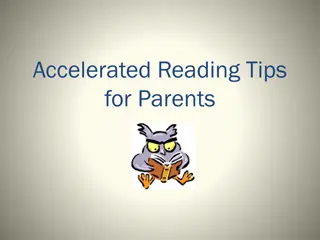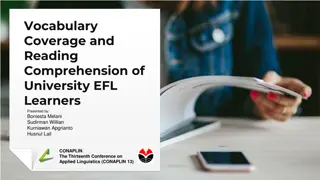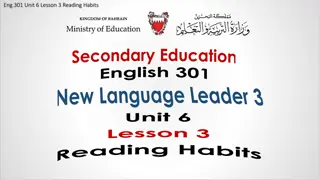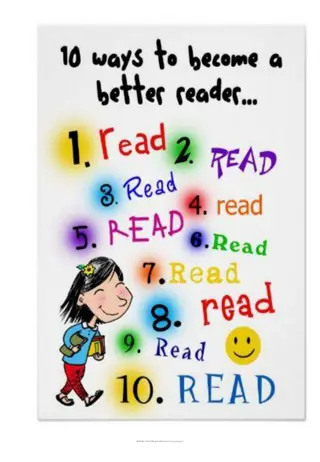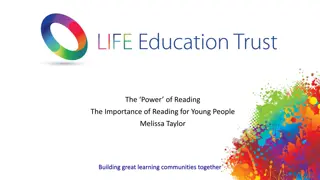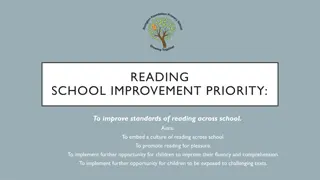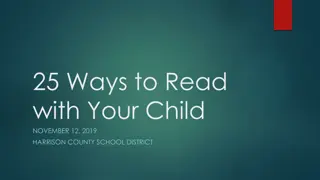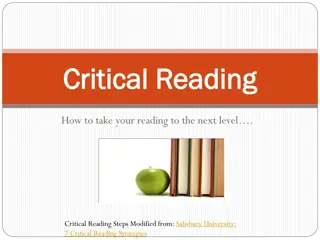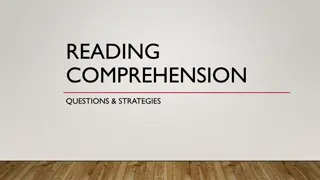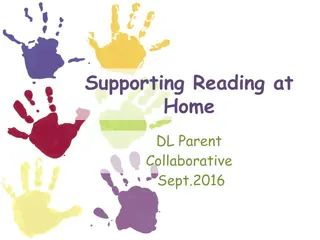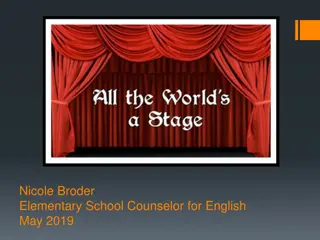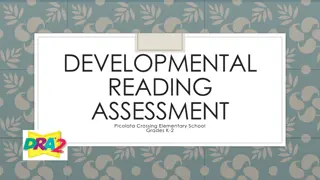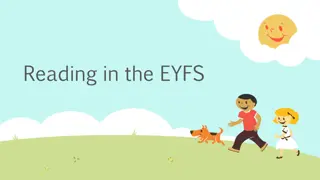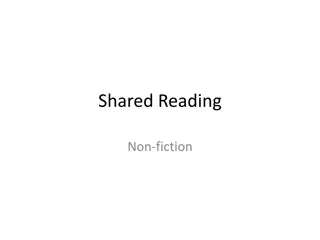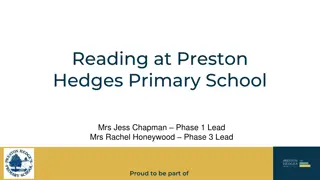Theologies of Reading
This resource provides insights on engaging with sacred texts in religious education. Explore techniques for reflective reading, discussion strategies, and ways to create a community of inquiry in the classroom.
Download Presentation

Please find below an Image/Link to download the presentation.
The content on the website is provided AS IS for your information and personal use only. It may not be sold, licensed, or shared on other websites without obtaining consent from the author.If you encounter any issues during the download, it is possible that the publisher has removed the file from their server.
You are allowed to download the files provided on this website for personal or commercial use, subject to the condition that they are used lawfully. All files are the property of their respective owners.
The content on the website is provided AS IS for your information and personal use only. It may not be sold, licensed, or shared on other websites without obtaining consent from the author.
E N D
Presentation Transcript
Theologies of Reading Approaches to Sacred Texts in the RE Classroom Jennifer Jenkins
INTRODUCTION How do you use text in RE lessons? Should text in RE be treated differently to text in other subjects? What is the purpose of engaging with texts? This introduction to Theologies of Reading both offers improved subject knowledge as well as ways to handle text in the RE classroom. We will consider: the basic idea: the Theologies of Reading the idea of making meaning as we read, or hermeneutics how this can fit into the new Ofsted (May 2019) Framework. How these ideas can offer different ways of thinking in RE, in other words, a multidisciplinary approach RESOURCES RESOURCES RE Double Entry Journal Schema Matrix Reading glasses template
1) Reading reflectively Starter question: why do we read? a) To gather information b) To see from the author s point of view c) To gain an understanding of a particular time and place d) To enrich our sense of the world In this section we will look at techniques to allow slow, reflective reading and open up conversations about interpretation and meaning
Bringing Reading into the RE Classroom Make space for oracy and reading aloud, and time to discuss the reader s positioning and pupils interpretations Slow down the reading. Take time. Emphasise different words. Talk about their meaning and different interpretations. How does a different emphasis impact upon the meaning? What roles do our experiences play in influencing our emphasis? Read in groups to develop a community of inquiry within the classroom. Describe this as a place for shared wisdom. Consider what texts say to individuals and to the whole as a group. Create class commentaries on texts; introduce commentaries made by others. Begin to see text along side commentaries. Evaluate interpretations of texts and discuss which ones are most convincing and why. Compare different translations of the same text. Use first language texts for EAL pupils to support their access. View texts in their original languages: Arabic, Hebrew, Greek, Sanskrit, etc. Discuss concepts of truth and meaning with pupils in relation to sacred texts. Invite them to write their own paraphrases of passages. Consider the theology of fictional texts such as An Inspector Calls or The Lion, the Witch and the Wardrobe. Work together with the English department or co-ordinate RE and English planning to support pupils in greater access to these texts. Based on findings of Dr Kathryn Wright
Using a Double Entry Journal Groups complete these as they read and discuss to yield a rich picture of the text and its meaning From the Text What is the passage about? From Your Mind What is your reaction? List some interesting language What is your theory or idea about this passage? What does it make you think about? What other stories or events does this passage remind you of? What explanation can you give for why this passage/story is still read or retold today? How important do you think this passage is to believers? What do other people in your group think about this passage? An important quote What is the key moment or event in the passage? What is the main idea, theme or concept? Is there a problem or conflict? If so, what is it?
More Text-Based Classroom Ideas Text Hunt- match up two texts and might be linked together. How? (also match with images) Oracy- The Bible is typically read alone when not read aloud to an assembled group. The Guru Granth Sahib is usually read together and treated as a person. How does it feel to read separately and as a group? Strip back clues they are dealing with a religious text and set a reading task for homework. Reading in pairs- two different colours. Pupils make their own highlights and annotation. What is similar and what is different? Conduct a silent debate around a passage of text and a question. Pupils can write comments in one colour and question other comments in another. Look at 4 translations of one text. What is retained in all? How do they differ in emphasis? Emojji translation to represent a line of text. Paraphrasing lines/passages into their own words. How are these similar/different across the class? What seemed to be the essential ideas to convey? Explode a text: pull out key words and phrases, add images and own ideas/interpretations about meaning.
Looking at Original Manuscripts Bring ancient texts to life Check out these sites where you can explore texts in original (or ancient) versions: https://www.divinity.cam. ac.uk/news/50-religious- treasures-of-cambridge Religious Treasures of Cambridge: to support learning at KS3 https://www.bl.u k/sacred-texts Sacred texts at the British Library; large annotated images. https://thevcs.org/ The visual Commentary on Scripture explores biblical teachings through works of art. Activity suggestions: Find 3 images that could act as commentary or response to a given text/verse Find one image to go with a specific text and explain your choice Find two different types of text, such as a Bible in two languages, to show diversity
2) Working with meaning and interpretation Starter question: how do we work out a text s meaning? a) The text communicates the meaning b) Text communicates several meanings, which we can then consider c) We need to know something of the author s context to grasp a text s meaning d) The text interacts with each reader uniquely to yield countless meanings In this section we will consider ideas about the relationship between reader and text and how a reader gains meaning from text.
Schema Schema is a developmental psychological idea, originally from Piaget, describing the way humans file information in the brain. New information or ideas interact with information that is already there. The word dog takes someone straight to their dog schema, which might be very different depending on the person; covering memories, associations, emotions and experiences as well as a definition of dog . A reader will encounter text in their own way due to schema related to words, meaning and text itself. THE SCHEMA MATRIX The brain makes connections in 4 ways: WORLD: the brain connects the text to your understanding of the world and people MEDIA: the brain connects the impressions you have gained form the media about the particular text and the people associated with it TEXT: the brain connects with your prior encounters with this specific text, varying forms of this text or other similar texts SELF: the brain connects the text to your own beliefs, opinions, ideas and anything of personal significance in the text.
What is Hermeneutics? Do we create our own meaning and project it into the world? Does the way we read religious texts reflect our assumptions about religious books, such as whether we believe them to be sacred or not? Hermeneutics is the study of interpretation of texts, particularly biblical and philosophical texts. It is an investigation into how humans make sense of the world and how humans communicate their ideas to others. The word hermeneutics comes from the Greek hermeneuo , which means to interpret . Hermeneutical study considers the lenses we bring to our reading, which shape the way we read and the understanding and meaning we glean from each reading encounter. SCHLEIERMACHER S PRINCIPLES Friedrich Schleiermacher (1768 1834)) is seen as the father of hermeneutics. He proposes there is no difference in interpreting sacred texts and secular texts because the meaning of both texts is affected by its history and the interpretation of the reader.
Schleiermacher and Hermeneutics Schleiermacher talks about lenses . Lenses can be formed by life experiences, a belief system, prior experience of sacred texts, knowledge of classical allusions, cultural experiences, etc. The act of reading brings another lens into play; the reader s attempt to understand the meaning as meant by the author of the text. The reader reads through her own lenses, but is also engaged in trying to work out the author s lenses, or experiences, beliefs and culture. Empathy and intuition are our tools as we approach the concept of an author behind a text. Some discussion questions: What is at stake when we read a sacred text? Truth? Theology? Beauty? Meaning? This may be different for all who read the same text. Is there one transcendent meaning behind a text or a plurality of possible meanings? Can anyone say with authority what ancient sacred texts truly mean? Are all interpretations valid? How are interpretations affected by the time period we live in and the lenses that gives us? Canon - why are some texts considered more worthwhile than others? Is authorial intent accessible? Are reader interpretations equally as valid as authorial intent?
Lenses as Disciplines We can looking at sacred texts through lenses more formal than individual experience and beliefs; the disciplines A discipline is a way of understanding the world, from History to Physics. To look through a disciplinary lens is to learn a particular way of seeing, as well as increasing understanding of the world, to think like a historian or physicist. Disciplines relevant to reading sacred texts (as well as religion and worldviews generally) are Theology, Philosophy and the social sciences, such as History and Psychology Wright, Georgiou, 2018 THEOLOGY: how does this religion/ worldview see the world, the universe, humans, the earth and human destiny? PHILOSOPHY: how can we know what information is true, or reliable? ETHICS (a branch of Philosophy): how can we know what is right and wrong, fair and just? HISTORY: what do we need to know about the past to understand religion and worldviews today? PSYCHOLOGY: what can we learn about human belief and behaviour that helps us understand human action in the world?
Echo Chambers An environment in which a person encounters only beliefs or opinions that coincide with their own, so that their existing views are reinforced and alternative ideas are not considered. (https://www.lexico.com/en/definition/echo_chamber) Can you suggest examples of echo chambers in today s media? Is it possible that sacred texts are read and understood in echo chambers ? Would this change the meaning of the text? Could finding out about interpretations of a sacred text from another tradition or even another religion bring new understanding to people of faith?
Grab Your Reading Glasses Questions for approaching a text with pupils Reading Glasses on: o What does it actually say? o What do I think it means? o What is clear about it? o What is questionable? o What does it remind me of? o How would read this? o What lenses do I bring to the text that affect my reading?
Drama Techniques to aid Reading These rehearsal room techniques used by RSC actors to get inside the text: Hot-seating (interview, use lines from the text in 1st person) Conscience alley (unpacking the subconscious, exploring bias) Select one word each from a text to present as a company of 3 to demonstrate key meaning Tableaux (representing a line, phrase or single word in freeze frame) Word carpet (phrases and text on paper on floor, can also add images, take partner on tour with their eyes closed, impact of text on individual, write own notes, comments, questions) Re-read with emphasis (tap the page for important words, step forward at important words to show power of text) Elongating different vowels (try recital with consonants clipped and vowels more elongated)
Questions to consider IMPACT What are the desired endpoints ? For example: - Pupils understand different ways in which texts have been, and can be, interpreted - Pupils understand texts have multiple meanings - Pupils progress in sophistication of understanding about texts - Pupils are aware of how their own reading lenses effects interpretation - Pupils show increased religious literacy INTENT First, ask yourself, what is the intent, or purpose, behind the whole curriculum, and the RE curriculum within your school? How does engaging with texts support the purpose of the RE curriculum? IMPLEMENTATION How can Theologies of Reading be implemented across the RE curriculum? How could a deeper engagement with texts, interpretation and lenses be implemented across the RE curriculum? EXAMPLES ON NEXT SLIDE
Examples of Implementation Different ways to approach reading: Lectio Divina (Christianity)- slow and reflective reading Recitation (Islam)- approaching the Qur an as recitations revealed from God Midrash (Judaism)- reading commentaries/ interpretation with the original sacred text Translations and original languages Find cartoon or infographic versions Read together- create a group meaning Use drama techniques to explore meaning (see RSC slide) Take one text (poem, sacred text, creed, prayer ) and: Before reading: hook and orientation During reading: explore, explain, expose After reading: review and reflect Reading strategies: which, why, when? Inspiring writing Exploiting wider learning opportunities Using journals and floor books Framework taken from http://justimagine.co.uk/course/take-one-book-book- based-planning/ Move deeper into layers of interpretation Approach texts from different angles Cultivate an appreciation of words: mystery and power Use text as a springboard into a unit of work
RE Reading and the Reading Content Domains for KS1 and KS2 Top Tip: Many of the techniques for approaching sacred texts support pupils in meeting content domains in the KS1 and KS2 reading curriculum. Having a text-rich RE curriculum contributes to developing learners as readers and brings academic rigour to RE.
Former assistant head teacher at a large primary school in Nuneaton. Former English subject leader (13 years) and Lead Teacher for Royal Shakespeare Company (2 years), as well as RE subject leader for 15 years. Currently working one day a week as RE Facilitator for Coventry and Warwickshire on behalf of both SACREs working jointly and some work for Coventry Diocesan Board of Education. ICON School Project Manager for Coventry Cathedral. ICONS are schools awarded a Cross of Nails (a symbol of peace and reconciliation following the Coventry Blitz in November 1940) for their commitment to teaching children and young people how to be peace-makers and reconcilers. Lover of all things literary and text-based and super fan of lifelong learning. Jennifer Jenkins RE Facilitator for Coventry and Warwick


